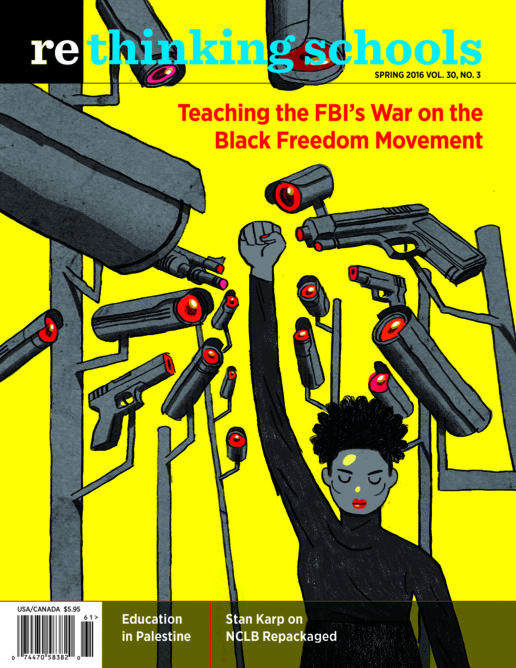ESSA: NCLB Repackaged

In December 2015, after years of gridlock and waivers, Congress reauthorized the Elementary and Secondary Education Act, the nation’s main federal education law, under the title “Every Student Succeeds Act” (ESSA). No Child Left Behind (NCLB) was officially buried, though hardly mourned. Although ESSA continues many of the test and punish policies that made NCLB a toxic brand, the shift does reflect more than a decade of grassroots activism and struggle on all sides of the political spectrum.
Passed in 2001, NCLB marked a dramatic change in federal education policy—away from its historic role as a promoter of access and equity through support for things like school integration, extra funding for high-poverty schools, and services for students with special needs—to a much less equitable set of mandates around standards and testing, closing or “reconstituting” schools, and replacing school staff.
NCLB required states to adopt curriculum standards and test students annually to gauge progress toward reaching them. Under threat of losing federal funds, all 50 states adopted or revised their standards and began testing every student, every year, in every grade from 3 to 8 and again in high school.
By any measure, NCLB was a failure in raising academic performance and narrowing gaps in opportunity and outcomes. But by very publicly measuring the test results against arbitrary benchmarks that no real schools have ever met, NCLB succeeded in creating a narrative of failure that shaped a decade of attempts to “fix” schools while blaming those who work in them. The disaggregated scores put the spotlight on gaps between student groups, but the law used these gaps to label schools as failures without providing the resources or supports needed to eliminate them.
By the time the first decade of NCLB was over, more than half the schools in the nation were on the lists of “failing schools” and the rest were poised to follow. In Massachusetts, which is generally considered to have the toughest state standards in the nation, 80 percent of the schools were facing NCLB sanctions. That is when the NCLB “waivers” appeared. As the schools facing sanctions and intervention grew beyond poor communities of color—where NCLB had made “disruptive reform” the norm—and began to reach into more middle-class districts, the pressure to revise NCLB’s unworkable accountability system increased. So then-Education Secretary Arne Duncan, with dubious legal justification, made up a process to grant NCLB waivers to states on certain conditions: If they agreed to tighten the screws on the most struggling schools serving the highest needs students, they could ease up on the rest, provided they also agreed to use test scores to evaluate all their teachers, expand the reach of charter schools, and adopt “college and career ready” curriculum standards and tests. Forty states said OK and were granted conditional waivers from NCLB.
These same requirements, which have no track record of success as school improvement strategies, were part of the Race to the Top program (RTTT), which turned federal education funds into competitive grants.
Rising from the Ashes
The results were disastrous. More than 4,000 public schools were closed across the country. Teachers and their unions were under siege. More than 300,000 teachers lost their jobs. The promised improvements in academic performance, even in narrow test score terms, never arrived.
In response, parents and students mounted the largest test resistance movement in U.S. history. This grassroots activism helped break the bipartisan consensus that had produced NCLB and RTTT and forced a new compromise in ESSA.
Although NCLB represented a massive wrong turn in federal education policy, ESSA is more like a change in drivers than a U-turn. The major elements of test and punish reform remain in place, but they are largely turned over to the states. The same grades and subjects must be tested, “challenging” standards must still be adopted and implemented, the “lowest performing” schools must be labeled and subject to intervention. But instead of the U.S. secretary of education, states and governors will be in charge of the pace and the details.
This could produce some modest openings for change as states replace their NCLB waivers, which expire on Aug. 1, 2016, with new state plans. But there are as many pitfalls as openings.
A Sliver of Light
ESSA permits states to pass laws protecting the right of parents to opt their children out of tests, but it doesn’t guarantee it. It ends the federal mandate for test-based teacher evaluation, but it promotes charter-friendly licensing schemes and “reformy” credentialing mills.
The development of new state plans could provide opportunities to roll back overlapping layers of testing or adopt more credible, supportive interventions than closing schools or firing teachers. A few states will be allowed to apply for a pilot program to revamp their assessment systems and adopt educator-designed, performance-based, portfolio alternatives. But the national testing watchdog FairTest warns that some testing companies and corporate interests are already promoting counterfeit versions of “performance” and “formative” assessments designed as adjuncts to existing standardized tests or stalking horses for more computer-based testing.
Many states are simply rebranding Common Core materials without significantly revising the standards or changing the tests. Most have already put test-based educator evaluation systems into laws that remain in place despite ESSA’s easing of federal mandates.
For more than a decade states, under federal pressure, have been expanding the reach of test-driven reform, closing schools, and promoting charters and privatization. Rolling back these trends will not be easy. The new law does not reverse the decline in federal education funding or require states to end the inequities at the heart of most state school finance systems. There is little money for progressive reforms, like integration or community schools, and more for regressive ones like unchecked charter expansion and merit pay.
Familiar fault lines surfaced as soon as the law was signed. The U.S. Department of Education, now under acting director John King — New York’s former education commissioner, who provoked massive parent resistance with his pro-charter, pro-testing policies — sent out a letter threatening states with loss of funds for failing to meet the new law’s “participation rate” testing targets. As education writer Jeff Bryant wrote, “Despite the new federal ESSA that weakens the consequences of nationwide standardized testing, the resistance to these tests that so shook the education establishment in 2015 will likely expand.”
The key, as usual, will be organizing and activism by parents, students, and educators. Building the opt-out movement, eliminating high school exit testing, and designing better ways of evaluating and improving schools can help replace the war on public education that has emanated from Washington, D.C., for far too long with a more hopeful vision.

